AnandTech Interview with Miguel Nunes: VP for Windows and Chrome PCs, Qualcomm
by Dr. Ian Cutress on February 14, 2022 9:00 AM EST- Posted in
- CPUs
- Qualcomm
- SoCs
- ACPC
- Interviews
- Qualcomm Summit 2021

During this time of supply crunch, there is more focus on ever on the PC and laptop markets – every little detail gets scrutinized depending on what models have what features and how these companies are still updating their portfolios every year despite all the high demand. One of the secondary players in the laptop space is Qualcomm, with their Windows on Snapdragon partnerships to bring Windows to Snapdragon powered laptops with x86 virtualization and a big bump in battery life as well as connectivity. The big crest on Qualcomm’s horizon in this space is the 2023 product lines, using CPU cores built by their acquisition of Nuvia. At Tech Summit in December 2021, we spoke to Qualcomm’s Miguel Nunes, VP of Product Management for Mobile Computing, who leads up the charge of the laptop division to see what’s coming down the pipe, and what measures Qualcomm are taking to bring a competitive product to market.
Miguel has spent 12 years at Qualcomm, working through the product management of the smartphone, tablet, and now compute portfolio. This involves managing multiple design teams globally, directing strategy, and enabling partnerships with OEMs. This comes on the back of seven years at Intel as an application engineer and technical marketing manager at Intel. Miguel’s background is heavy in the interface between engineering and actual end product, and it’s clear in talking to him he likes to get his hands deep into how the systems he manages performs.
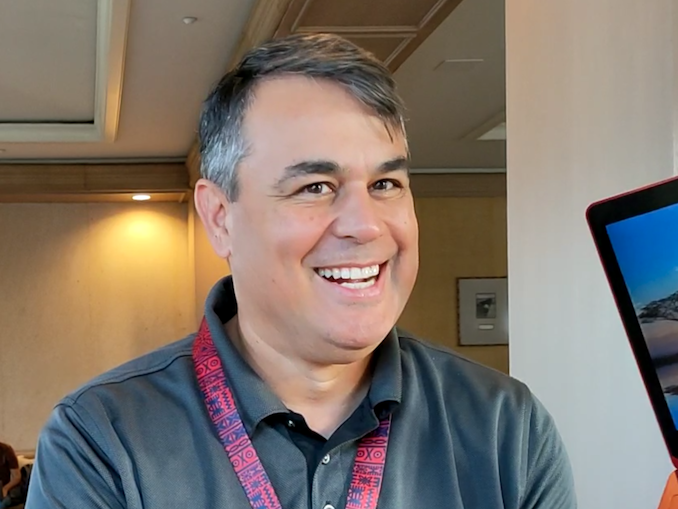 Miguel Nunes Miguel NunesQualcomm |
 Ian Cutress AnandTech |
Ian Cutress: My first question I think is one that's quite personal to me, because I've been waiting for it for so long! We finally got the announcement that 64-bit x86 emulation is coming to everything Snapdragon 7c and above running Windows 11. Why has it taken so long?
Miguel Nunes: It took a bit of time to get right! If there is one thing we've seen going through a lot of these application journeys, is that there's a lot of badly written software out there! I mean, there is. It has nothing to do with the architecture really, but the software can be horribly… just the amount of issues you run into. It is not stuff you expect. Just strange stuff pops up that you need to work through.
IC: Are you talking like instruction flow not really mapping properly to the core?
MN: There was some of that, but you’ll probably understand what I mean when I say that half the stuff we saw was installer bugs doing ‘if machine’ type checks. So the install fails, or the driver doesn't unload because it's trying to put it in the x86 directory. I mean just little things like that, that has caused problems. So yeah, while it should have worked on paper but it doesn't because it's in the wrong place, or the DLL isn’t loading, stuff like that. We took a while to get there. In terms of instruction optimizations, I think there are some that aren't super optimized, but that wasn't the majority of issues. The majority of issues are mostly just loading issues, CPU detections, and there's a lot of software out there that use libraries they get from somewhere else. Those libraries are doing the right thing, so it's just a linking problem, and it took a bunch of time to get that stuff ported. So you'll see a bunch of open-source stuff ported as well. It just takes time to get that ready.
IC: So it's not necessarily an instruction translation issue, it was dealing above that at the OS layer?
MN: Yeah, it was stuff we didn’t expect. But it [Windows] is a legacy ecosystem that hasn't changed - so nobody's had that problem before!
IC: And compared to some other x86 translation models by your competitors, who own their own ecosystem, sign the software, they don't necessarily have those issues.
MN: [nods] That’s right.
IC: There were some previews with Windows 10 with it enabled, but you’re doing a clean cut with Win11. Is there a technical reason behind locking it into Windows 11?
MN: Not our decision. There’s nothing technical.
IC: So it’s purely a next generation of hardware, it's all Windows 11, so let's have that as the starting point?
MN: Yeah, it wasn't a Qualcomm decision. You’re right, because if you think about the previous OS is Windows 10, and Windows 11 is the new platform. It was a Microsoft decision of where it lands.
IC: At this event, I know this year Qualcomm isn’t saying much about the Nuvia acquisition, but at the launch Qualcomm said that in 2022 there would be sampling silicon, for 2023 products. That was reiterated that at the investor day a month ago. So everything's still on course?
MN: Yes.
IC: Just to clarify for me, is Nuvia working on a specific core? Or is it a full SoC, paired with an Adreno GPU and Qualcomm’s 5G and others?
MN: It's a good question, because I know everyone thinks ‘Nuvia chip’. It requires a lot more of a chip than what Nuvia had [when we acquired them]. They were mainly the CPU core at the time. There is a fabric around that as usual that glues it together, with our optimized memory IP and stuff around that. So think of it more on the CPU performance subsystem. On the GPU, we've got the GPU assets in Adreno. We're [going to be] making a lot of changes there too. On the GPU side we’ll be making it more PC friendly, and then we are scaling the other stuff such as AI, and other things like that too. Nuvia is part of the solution, but there's other stuff there of course.
IC: Traditionally Qualcomm has used a big/little, or a big/medium/little hybrid design. It sounds to me that Nuvia is solely working on that high-performance core. Can you expand if they're doing an equivalent efficiency-core to go with it? Should we expect that to be something to be called Kryo?
MN: We will have two core structures that will be similar to be what we already have. We really believe that the performance and the efficiency optimized combinations work. We see that in our long battery life data, because a lot of the workloads don't need that performance. So you will see that structure still in place - what exactly we do on each core, is TBD. But you will see a similar structure - you just won't see a bunch of big cores!
IC: The goal with the Nuvia design is to scale from 7c+, all the way up?
MN: Oh, eventually we want to use it across the board. This technology scales really well. As Cristiano and others have mentioned, our focus primarily is going to be after the higher performance computing first, but our roadmap will scale. The other thing we will see us try to do, which we've been trying for a while in this industry, is to accelerate. The notebook industry is a little bit slower than the mobile industry, so how do we accelerate the pace of innovation? So you'll see some activity there as well so that we can really drive innovation faster.
IC: At the investor day, it was quite poignant that on the slide it said ‘Nuvia Team’. So should we think of the Nuvia team as a separate design house internally, compared to say, Kryo and Adreno? I'm wondering to what level they're integrated into the company? Last I heard, they were still in the same offices they were when they were a startup!
MN: I think a lot of that is just COVID, regarding offices and things like that. But no, they're part of the company, and they're part of the team here. I see them as our CPU team. We do have different teams, so it's hard to say because some teams in one location will work on a core, others work on another core, but at the end of it, they're part of a team. They’re just part Qualcomm, they're not separate, just part of our CPU team.
IC: In terms of internal roadmaps, the big focus with Nuvia is this first laptop-focused chip in 2023. Usually when we speak to companies, especially the size that Qualcomm is, we discuss 3-year, 5-year roadmaps, and then 7-year exploratory roadmaps. Is that all on the cards with the Nuvia team?
MN: Oh absolutely. We're looking how we scale the capabilities way into the future. Do you want to see our long-term roadmap?
IC: Yes, please!
MN: [laughs] But for sure, you know it's something we want to leverage as much as we can. The technology is great, we've got the performance, we've got the efficiency, and we've got so much IP that we feel pretty good. You've probably gathered that, as we hinted at analyst day, we feel pretty good that we can build out. It’s really awesome.
IC: One question that has come up which I think is relevant given what Apple is doing in the space - A lot of the senior staff at Nuvia are the people who actually were behind that chip. But because Qualcomm is focused on this Windows on Snapdragon ecosystem, do you see the competitor for that Nuvia laptop to be Apple because both the chips are ARM-based, or Intel, because with Intel, you're both using Windows as the main operating system?
MN: That is a really good question. You know, I would honestly say both, and both in the sense that, there's going to be ‘within ecosystem’ competition, because one ecosystem is a Windows ecosystem and one is a Mac ecosystem. It also depends on the segment. I would say it's probably a segment question. Because if you look at certain segments, Windows is king, and that is saying they are the majority of that segment. So for there, Intel is our competition. Then for other segments, we can provide the same capabilities, if not better, than what Apple is doing. So it depends on the lens you're looking at it though, but it's really both. And we're fairly agnostic, and honestly, if it's Windows or if it's Chrome in that space, our value is independent of the operating system. There's a lot of work that goes into the operating system tuning and, getting the product working well, which Microsoft spends a bunch of time doing, but you know, our platform is independent of that.
IC: So at this event, you're announcing Snapdragon 8cx Gen 3. Is it a holdover until the Nuvia-equipped chips are ready?
MN: No, no, not at all. The way I would see it, and when you see the stuff we talked about when you get your hands on - the data we showed puts our 8cx Gen 3 as a mainstream product. So you'll see our comparisons are against mainstream Core i5, which is really still the mainstream CPU for consumers. So that's where 8cx Gen 3 competes really really well. You'll see the performance, the power, and you’ll see the AI story perform really well. That's what we meant to do.
It was targeted there, targeted at the main segment. Our roadmap in the future takes us in a different level of performance. So it's just literally different tiers, and we believe we have to keep the tiers going, because this market is a killer market. Even our Snapdragon 7c+, the stuff we're doing there is really keeping the good/better/best model going and bringing value to the entry tiers. It’s really interesting actually - the entry tier has evolved so much over the past 24 months, more than I think anybody expected, and so there's a lot of value there, too. So we will continue to go after the good/ better/best or the low/mid/ high type of products.
IC: So one of the things that has interested me is that Qualcomm plays a lot in this ultra-thin, ultra-portable market – it’s called an ACPC, but it's ultra-portable with additional connectivity in a traditional sense. What's the scope for going beyond that? Currently we see the ultra-portable market around 15-20 watts, maybe up to 28 watts, but then the laptop space also expands to 45 and 65 watts. Qualcomm has Adreno graphics IP that the company keeps saying it scales – but does it scale to something bigger?
MN: It's an interesting question. You know, this wattage thing, either way, it drives me crazy, because what are you comparing it to? TDPs are a little bit mysterious as it depends on how you measure TDP. But we will deliver performance TDP, and this ‘higher level TDP performance’ at a lower tier. So even you'll see today, when we'll show you will show you i5 level performance, which is at a 22 watts TDP, we deliver it at like 9 watts. So we'll deliver perf at a TDP.
Honestly, you know, to tell you the truth - we can scale pretty high. It's what the market wants, and what products we aim to compete with. But we want to compete in the ultra-mobility space because it’s important to us. We are not focused on desktops today and things like that, but if the market sees value, and our products are good in that market, it's something we definitely look at. We focus on the mobile market, but with a much higher level of performance at a lower TDP.
IC: So just for my personal edification, when you say ‘22 watts performance at 9 watts’, that's great. But I just want that same efficiency at 22 Watts!
MN: You want higher performance at the same TDP! Which again, it's a good question - very few people understand that. It's going to be an OEM design point choice. The OEM decide if it wants to build a thinner form factor, or it wants higher perf at the same TDP. I think there's probably a combination of both, but we will scale fairly well, but still at a significantly lower TDP than what you would get with others - significantly. So then the question is whether it is time [for Qualcomm to move into the new market]? I mean, I'm a big fanless believer, and so I like fanless designs. But we could scale on the technology. So it's really about what are the products the right design points/
IC: I'm coming to your event with the Intel flagship EVO design laptop – a Core i7-1195G7 in the MSI Prestige 14. On the plane it gives me 16 hours battery life - which I know is still technically six hours less than what Qualcomm provided three years ago, but it runs all my software. At what point does Qualcomm demand a minimum specification? You already have reference designs - at what point do you design with your partners an equivalent to the Intel EVO ecosystem ensuring that all designs meet very specific certification, as well as driver support over 12/24 months ensuring that performance is still high? Is there scope for that sort of platform in your ecosystem?
MN: You know we don't have a platform like that. It's interesting - we believe that every product should be optimized. That’s where we work with our partners - we really push that aggressively. Every product should be optimized to the best capabilities. You'll see this when we talk about security, as we’re not simply throwing a bunch of security features in there. We don't believe, we don't want an EVO programme, we don't want a different thing - everybody should get a good minimum. Why shouldn't you, as a consumer. get the best security? You don't want to go create a bunch of sub-brands and confusion in the market - we want every product to be highly optimized.
Ultimately, just look for the Snpadragon logo, and you get security, and you get higher efficiency. Maybe it's a scale thing, as we can do it now, because we are working with a smaller number of designs. In reality, we could do it, and but we just want to get to a point where we the software is so highly optimized, we won't see a lot of product variants that are outside of components selection.
IC: I’ve got a few choice words for some of your partners on that!
MN: [laughs] It's not like getting in the x86 world, as when you design those things, cooling is a big deal because it’s going to throttle if you don’t optimize. That's not an issue for us. We have a good system design, and it's easier for people to follow - then it comes down to component choice: are they picking the right displays that are not power-hungry, stuff like that.
IC: So I notice you have a Snapdragon 8cx Gen 3 laptop beside you - is that the Qualcomm reference design, or is that a partner design?
MN: It’s our design.
IC: What’s so special about it?
MN: It's actually what we use to develop o. It's a real thing, it’s a real PC, and it's a real form factor. It's usable, and I use it as my daily device now, so it's a real thing.
IC: So it's a development platform, not a reference design?
MN: For us it’s a development platform, both hardware and software. We have a bunch of connectors in here that connect and stuff, but it's as close to a real product as possible.
IC: It’s a very vibrant red!
MN: Snapdragon red. That's why we had it made.
IC: Do you mind me asking who your partner with that is?
MN: We used one of the more mainstream ODMs. We designed it and they just manufactured it.
IC: And you’ve got two cameras at the top?
MN: Yes, and we have other demos with other cameras in the demo room.
IC: Speaking of things that use AI functionality, I use NVIDIA’s RTX voice on my main PC for live recordings to help with background noise. But if I already have audio recorded, there's no RTX Voice-like post-processing software that I can just drag a file into. If you have the hardware, can Qualcomm do it?
MN: When you asked me this last night (before the event), I said I’d look into it for you. The result is I think we can! We’re preparing a demo on it. I asked the internal team if we can post-process, and we actually can.
IC: Also on the AI front, this has been one of Qualcomm’s strengths in smartphones. But when it comes to laptop design, your competitors have a problem with the fact that there aren't that many applications that they can focus on when they talk about AI, aside from camera, and they start clutching at straws to promote the AI. Ultimately they’re optimizing some software that has limited scope. So how are you approaching the messaging and the application as it comes to ACPC AI?
MN: We'll have some demos on stage today with us with Microsoft, and you will see them talk about AI and some of the things they're doing. We see significant value for AI in productivity use cases. If you just think about all the stuff that's happening in the cloud, Office 365, there's a bunch of stuff. There's a lot of AI processing in cloud today, but you want to bring that closer to the edge. So a lot of productivity things for Office, and a lot of things in Microsoft Teams. A lot of it is centered on the camera, but it's not just for pictures, it's for taking the camera inputs and using it for things. So you'll see a lot of innovation around that.
As you know, the processing power you need to run that stuff is very high. In our Snapdragon 8cx Gen 3, we have 29 TOPs of AI. It's just massive amounts of AI performance, and we will use it all.
IC: Is that 29 TOPs for CPU, GPU plus Hexagon, all three combined together? (MN: Yes) Do you actually have software that can use all three simultaneously, or are you relying on three separate applications using it?
MN: It depends on the software. There is software that could go across them, and then for some software it makes sense to use one accelerator versus the other. But you could go across them if you wanted to.
IC: So could I argue that you're focusing a lot on corporate use case for AI acceleration first, because that's been your major market today?
MN: Correct, yes. I think that's where we all relate to, because we've been using these things so much for Teams, and Zoom, and things like that. There is just so much stuff you can do to make those experiences better. Resolution cleanups, I mean, there are so many things you can do.
IC: Video upscaling? So you can just transmit 240p and it scales to 1080p?
MN: Lots of things like that. Cleaning the background lights, as cameras on these things aren't always great, to make it look better. So there are lots of different things around that, and we've got a big focus on camera too - cameras have become super important in PCs all of a sudden. So a lot of work on camera, audio, and it's a lot of use cases including productivity, so it's not just one thing.
IC: Please mandate a minimum 1080p 60 fps camera in every Snapdragon laptop!
MN: Oh, I wish I could! I would like to go higher than that! But yes, we know what you mean.
IC: With everything Qualcomm is announcing at Tech Summit about ACPC, what do you think will fly under the radar that people should actually focus on?
MN: It's a good question. There are certain things we're doing to camera, and with audio, where people have it good today, but it's not great. It could be so much better. The enhancements we're making are really going to make it so much better. Some of this stuff is not new per se, but it's significantly better than what most have, and it's possible to improve those experiences and I think a lot of the laptop experiences are becoming closer and closer to your phone.
IC: Do those experiences still rely on the OEM buying into those features?
MN: Not that much. In fact, one of the things we want to do, and back to your Evo questions, is just to make sure that some of this stuff is everywhere. Just the basic capabilities that everybody should get - it's not optional and it's just in your product. Everybody should have great audio, and we will work to make sure that those features are there. Even with cameras, as an example, we’re working with the sensor ecosystem to make sure that the PC OEMs have access to sensors that are actually better than 720p. There's a whole enablement piece to go make those things standard. Our goal is to ensure every device is going to have a great experience, not just the special ones that OEMs that choose to make.
Many thanks to Miguel and his team for their time.


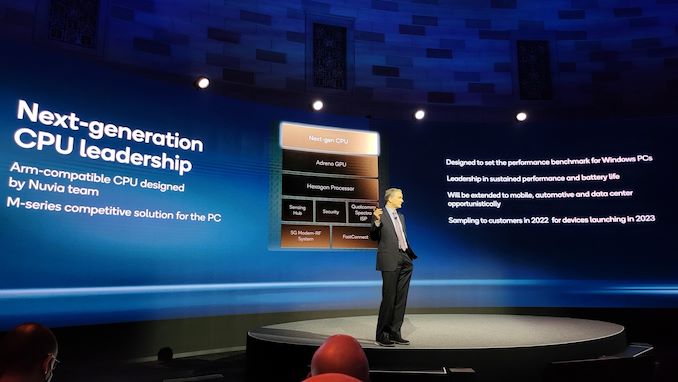
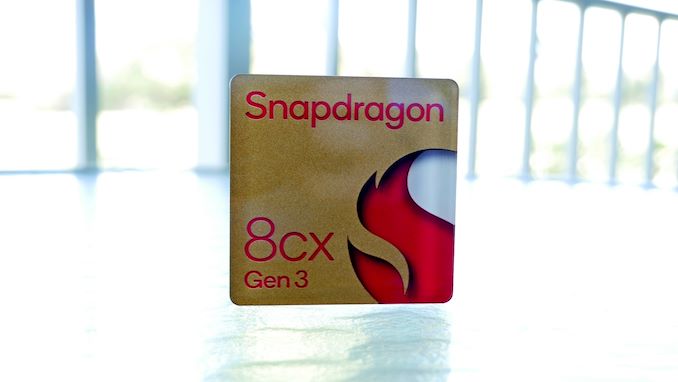
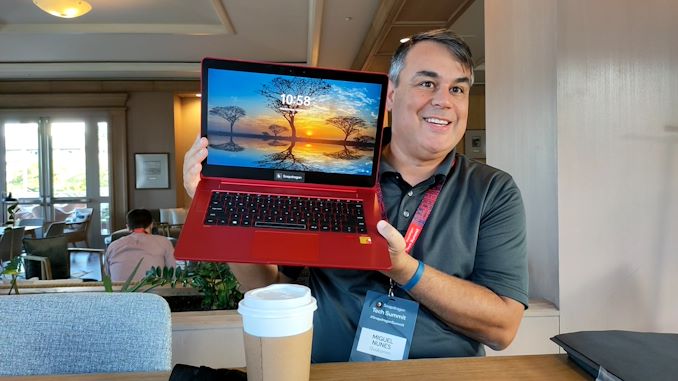
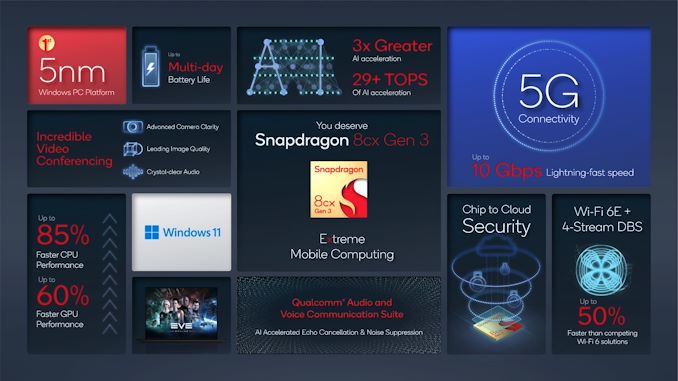








37 Comments
View All Comments
Dolda2000 - Monday, February 14, 2022 - link
>[...] you’ll probably understand what I mean when I say that half the stuff we saw was installer bugs doing ‘if machine’ type checks.Sigh. Yes, I do understand.
gijames1225 - Monday, February 14, 2022 - link
It's weird that Qualcomm used to be leading in custom core design, and then totally dropped out of that race for almost a decade and had to buy their way back in. I mean, I'm glad we'll see more competition in high performance ARM cores, but it was just such an extreme strategic fumble to stop building custom cores after the Snapdragon 800 / 805.Raqia - Monday, February 14, 2022 - link
The saga of Qualcomm's CPU team is directly related to Broadcom's attempted, but shut down hostile bid for the company a few years back. They had diverted CPU engineering resources to a server project which was well reviewed but ultimately scuttled by management after making promises to big institutional investors to cut costs in order to thwart the (very low) bid by Hock Tan and a hedge fund he looped in to close the deal.At the time, ARM's stock CPU IP was doing better than Qualcomm's internal IP both due to the diversion of resources to servers and availability of very good designs out of ARM. The CPU division was less impactful to mobile designs (outside of very specific benchmarking) as well as a separate wing from Qualcomm's core SoC competency due to its then server focus that could be cut to appease large institutional stock holders so it went on the chopping block as they promised.
It seems like they appeased investors after their legal victory over Apple and the US FTC, made plenty of money from design wins at Apple / product line diversification and saw trajectory of ARM's designs was leveling out so they went out to source a core design Nuvia which turned into an outright buy. Indeed, the acquisition of key former Apple talent was a nice FU back at Apple for its bullying through legally flimsy complaints and international coordination with near sighted regulators.
fmcjw - Tuesday, February 15, 2022 - link
Execution is another matter, not only at Qualcomm, but Microsoft. I'm skeptical Windows on ARM will be as good as it is on x86 by 2023, so the new SoC will probably be best for Linux or ChromeOS, which is to say, not mainstream. And the 2 year old tech in Snapdragon 870 is plenty for Android. MediaTek is pretty opportunistic here, riding on ARM stock designs and leading edge processes, and taking a wait-and-see attitude towards laptop SoCs. If Windows gets Windows on ARM right, I'm sure the latest MediaTek 4nm X3 SoC in 2023 will serve Android AND Windows pretty well. If anything, Qualcomm needs to pay for WoA development and somehow legally prohibit others from using its optimizations, which goes against the Windows run anywhere philosophy.Raqia - Tuesday, February 15, 2022 - link
I think the situation with Windows 11 on ARM is quite good:https://youtu.be/nrvnpFCcZeA
Note this is running on almost 5 year old hardware with less than ideal GPU drivers (CPU emulating Direct X for 64 bit software). It would be a treat if OEMs and Microsoft collaborated to enable Windows to be side-loaded on phones which even come with hypervisors now; making it usable with your usual peripherals and monitors shouldn't be a huge deal either.
I think Microsoft is fully invested in ARM due to the lack of suitable x86 hardware for ultramobile purposes. Rumors of HoloLens' demise have been greatly exaggerated, but they are going with ARM or nothing in the next 5 years for any of these form factors.
iphonebestgamephone - Thursday, February 17, 2022 - link
A 4 year old soc running 10 year old games sure is impressive.at_clucks - Tuesday, February 15, 2022 - link
"FU back at Apple for its bullying"Awww, poor Qualcomm, being bullied by Apple. What a bad place to be, someone abusing their position and bullying everyone else with through legally flimsy complaints. It's almost as if Qualcomm got way less than it deserved: http://regulatingforglobalization.com/2018/02/15/4...
Raqia - Wednesday, February 16, 2022 - link
If you took a moment to actually compare Qualcomm's model to say Intel's, you'd realize they're adopting an IP licensing model that's actually led to vibrant competition and better consumer pricing and products than one where IP is jealously guarded and improvements and prices stagnated over a decade. (Just compare cellular SoC pricing to x86.) This is impressive given that cellular technologies are far more complicated and valuable than CPUs in both specifications and implementation and require vast amounts of investment.None of Apple's claims held water either: Qualcomm capped its royalties and they effectively constitute a discount for producers of cheaper phones (i.e. Apple competitors) and its IP is practiced and forms a network at not just the level of the modem, but RF, antenna, cell tower, network etc.
Much of media was aligned against Qualcomm because Apple was such a lovable, unstoppable virtue signaling juggernaut, but some could pierce the veil:
https://www.bloomberg.com/news/features/2017-10-04...
Courts did examine both the competitive and legal aspects with the US 9th circuit concluding Qualcomm was "hyper-competitive" rather than "anti-competitive" in an unusually lengthy opinion granting Qualcomm's appeal of the case:
https://cdn.ca9.uscourts.gov/datastore/opinions/20...
I would take another look before holding fast to conclusions.
uefi - Monday, February 14, 2022 - link
For a second there at first glance, I thought you interviewed Devin Nunes.PlasticMouse - Tuesday, February 15, 2022 - link
I particularly liked Ian's comment about how a lot of vendors are clutching at straws when it comes to promoting the on-board AI capabilities of their chips. A lot of it seems to be focused on better audio processing and video effects. Can someone elaborate how edge AI might improve the PC user experience?